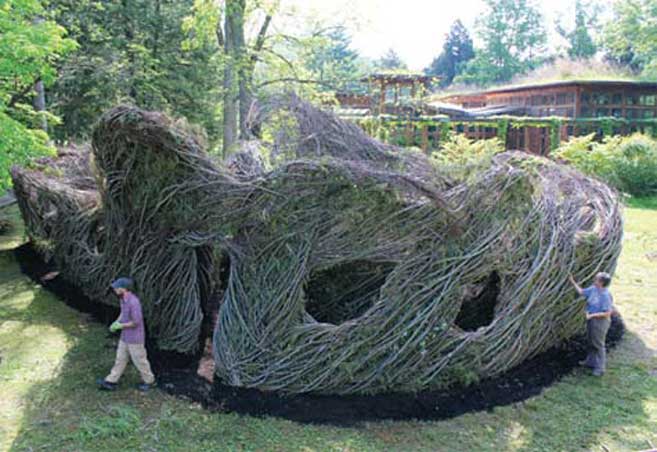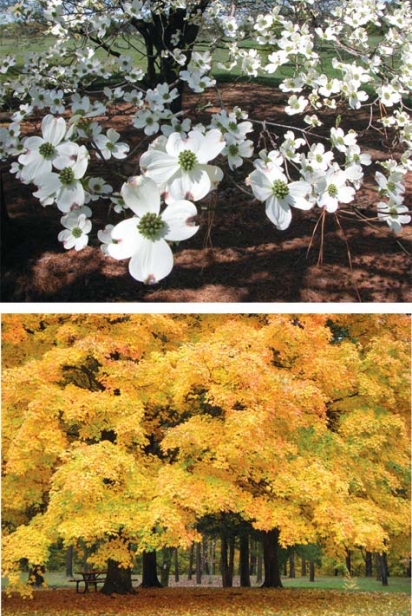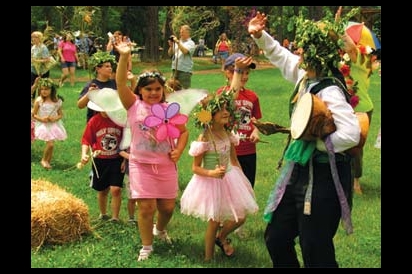Escape to Nature
Bernheim legacy lives on —and we’ve never needed it more
To impatient 6-year olds in the back of a station wagon, the 25-mile drive to what was then Bernheim Forest seemed interminable.
Those were days when children were turned loose in their neighborhoods to play four-square or climb on new construction. Bernheim offered another world through which to run, and steep mossy slopes to climb. There were different squiggly and creepy things under rocks, and shallow streams to slip into as kids tried to balance on rocks. Lunch came from a picnic basket. Before most homes were air-conditioned, it was welcome relief to play under the high, cool tree canopy in June.
Generations of children have been taken by their parents or teachers to what is now Bernheim Arboretum and Research Forest, to feed frogs, walk forest trails or fish in the lake. These days, the drive doesn’t seem so long — just a little south of the Zappo’s outlet.
But it is still another world. One set aside for humanity by a prescient bourbon magnate, Isaac W. Bernheim, who had purchased more than 12,000 acres of depleted farmland in Bullitt and Nelson counties and deemed in 1929 that the property would be “ held in trust ... for a park, for an arboretum and, under certain conditions, for a museum, all of which are to be developed and forever maintained as a center of friendly intercourse for the people of Kentucky ... as a place to further their love of the beautiful in nature and in art ....”
Bringing people “from city, village, hamlet and farm,” Bernheim’s intention was to welcome everyone, making no distinction between “rich or poor, white or colored ... all will be treated with an equal consideration” to enjoy nature. From breathtakingly beautiful trees blooming in spring at the entrance of the arboretum, to stark bare black trees against an overcast winter sky, Bernheim offers the pleasure of calm to residents of a world where busyness is a common denominator.
A lot of diversity can happen across 14,000 acres, and Bernheim doesn’t fall short of its mission to be a leader in education, conservation and outreach. Visitors can participate in “an awesome evening of amphibian fun” (according to the website), investigating the frogs and toads of the area with a naturalist (May 25, 6:30 to 9:30pm), or take part in a macro nature photography workshop (May 26 and 27). There are grueling full- and half-marathon trail runs on June 2. For less robust nature lovers, there are family fishing days on June 2 and 3.
Part sanctuary, part research institution, part playground, part classroom, Bernheim has brought much to generations of hikers and fishers, plant lovers, gardeners, bird watchers, wildflower seekers and millions of others.
Hiking a trail in Bernheim (there are at least 15 trails, a total of 50 miles, ranging from half a mile to 13¾), your surroundings might seem only like generic “forest.” But the researchers at Bernheim have identified six different forest “communities,” specific combinations of trees, shrubs and low plants indigenous to certain microclimates formed by flat land and streams (sycamore, tulip poplar and sweetgum trees), or rocky rises where the terrain is steep and dry (white oak and chestnut oak).
Wildflower seekers prefer the beech and sugar maple forest, found along damp ravines, where they can find native species like twinleaf, bloodroot, jack-in-the-pulpit and trillium, and the indigenous pawpaw tree.
Despite its name, Bernheim Forest isn’t — at least not all of it. Native grasslands, “the Little Bluestem community,” are also found at Bernheim, containing diverse species typical of the prairies, including St. John’s wort, yellow coneflower and wild petunia. There are occasional controlled burns of grasslands and other spots in Bernheim, allowing for research and restoration of native plants. The largest burn was 320 acres in an oak-dominated forest, and will allow researchers to determine the effects of fire on oak regeneration and diversity of herbaceous plants growing on the forest floor.
In all of these ecosystems research, education and conservation continue, sometimes by outside investigators — one has studied invasive Japanese stilt grass; another cataloged 200 types of lichens, including discovery of the ultra-rare Pyrenula plittii — and sometimes by staff, who have designated a list of “Bernheim select” plant species that do particularly well in the local environment.
In 2009 the first of 2,000 quail were released at Bernheim. Native to the area, Northern Bobwhite Quail populations had disappeared from the area in the 1970s because their habitat had been disturbed. As Bernheim staff worked to rebuild that habitat, natural-areas manager Ronnie Moore raised quail in a small outbuilding on the property; groups of the birds have been released each year since then. These days, the distinctive bobwhite call can be heard regularly, and the birds appear to be thriving.
There are many destinations at Bernheim, but all who venture in should probably begin at the Visitor Center, where you can plan your day — pick up a bird checklist, a map or a cool drink. This building earned a platinum rating (top honors) from Leadership in Energy and Environmental Design (LEED), the nationally accepted benchmark for design, construction and operation of green buildings.
The center’s walls are mostly glass, which give the feeling of being outdoors while indoors. Much of the lumber for the exterior walls is reclaimed wood, including old pickle vats. Bathroom stalls are built of recycled milk jugs and other consumer waste. Bathroom countertops are made of recycled glass and cement; no petroleumbased products are included.
Outdoors, rainwater from the parking lot rinses oil, gasoline and other car residue into a former streambed, where dead and decaying matter has been inoculated with mushroom mycelia and spores. As they grow, the mushrooms break down toxic petrochemicals into nontoxic or less toxic substances. On the north side of the center, a screen of evergreen trees protects the building from north winds and lowers heating costs. On the south side, deciduous trees shade the building to cool it in the summer, then drop their leaves and let the sun through in the winter. The roof is planted with native grasses and flowers, providing habitat for butterflies and birds and decreasing energy costs for the center’s interior.
A trip to Bernheim always promises a day (or night) of activity that can bring all ages closer to nature. A 6-year-old might turn over a rotted log to find a slimy salamander (Plethodon glutinosus), build a faerie house with natural materials or wade through a clear stream. A grown-up might run a marathon, take a full moon hike (June 4, 9 to 10:30pm), or find a quiet spot to do nothing in particular. Sarah Fritschner is coordinator of Louisville Farm to Table and a trustee at Bernheim Arboretum and Research Forest.
Bernheim Arboretum and Research Forest
Where: Just off Interstate 65 south of Louisville at Exit 112 (Clermont/Bardstown exit). For GPS: about 2499 Hwy 245.
Hours: Gates are open daily, except Christmas and New Year’s Day, from 7am until one hour before sunset. Please check website for exact closing gate times. The Visitor Center and Education Center are open 9am–5pm daily.
Where to eat: Isaac’s Café, open 11am–4pm
Admission: Free Monday–Friday, and every day for members. For nonmembers, Saturday, Sunday and holiday entry fee is $5 for cars, minivans or motorcycles.
Annual memberships: $50 for couple/family
Information: 502-955-8512 or bernheim.org
Special events
BloomFest!: Bernheim’s annual celebration of spring flowering trees, features the popular Woodland Faeries Costume Parade, nature discovery stations, kite flying, Kentucky craft artists, live music, great food and more. BloomFest! includes a plant sale that features Bernheim Selects (plants that do well in this area). Members get to shop before others from 8 to 9am.
ECOKids: “Every Child Outside” occurs every first and third Saturday, allowing children (and their parents) to play outside and discover nature. ECOKids activities are posted on the Bernheim website. On May 19, award-winning Bernheim naturalist Wren Smith will help children build faerie houses with natural materials.
CONNECT: An event described on the Bernheim website as a “collision of art, music, science and technology” and “as a creative dialogue between artists, scientists, naturalists, lunatics, sustainability advocates and progressive thinkers, all gathered in nature.” The fourth annual CONNECT, scheduled this year for August 25, starts two hours before sunset and ends two hours after sunset, including kids events, food and live music on two stages. After dark, activities include fire and light—fire sculptures on the lake, images projected into trees and other events using the dark as a backdrop.
If you’re in the area of Bernheim, you might check out these other sites:
- Jim Beam Distillery is the first stop on the western end of Kentucky’s bourbon trail, and it is located just east of Bernheim. Bourbon tasting and bourbon sales are offered daily. Stop in Monday–Saturday 9am–3:30pm and Sunday noon–4:30pm. Guided tours of the rackhouse, historic home and grounds are offered 9am–3:30pm. Monday–Saturday and 12:30–3:30pm on Sunday. 502-543-9877; www.jimbeam.com
- Forest Ege Winery has been open five years, sells nine types of wine and is located mere yards from the Bernheim entrance across Kentucky 245. Hours for tastings and shopping are 11am–6pm Monday–Thursday and 11am–7pm Friday–Saturday. 502-531- 9610; www.forestedgewine.com
- Thomas Merton fans and others may want to visit the Abbey of Gethsemani Visitors Center. It’s a 40-minute drive from Bernheim, but it’s a can’tmiss for many people. There are 1,200 acres open for hiking and a welcome center with a film, archives and shop open Monday–Saturday 9am–5pm; closed on public holidays and holy days of obligation. No advance arrangements are needed to attend church services or walk the grounds. 3642 Monks Rd., Trappist, KY 40051; 502-549-3117; www.monks.org
- Wickland, former home to three governors, is considered one of the best Georgian-style houses in Kentucky, built around 1825. Open May through Labor Day, Friday–Sunday 10am–2pm at 550 Bloomfield Rd./Hwy. 62, Bardstown; 502-348-4877 or 800-638-4877. There are self-guided tours, a quilt exhibit and other displays. A 90-minute family-friendly “spirit tour” starts at 7pm most Friday and Saturday evenings. An arts and crafts sale will be held June 9–10, 10am–6pm on Saturday; 10 .m–5pm Sunday. Festivities include food and home tours for $2. www.visitbardstown.com/wickland
- Chapeze House aka the Kentucky Bourbon House is a historic location for dining and bourbon tastings led by Kentucky
Colonel Michael Masters, author of Hospitality Kentucky Style. Shop at the gift shop or make reservations for dinner and/or a wide choice of bourbon flight tastings at 800-704-4917 or info@kentuckyshomeforbourbon.com. Located in downtown Bardstown at 107 E. Stephen Foster Ave.; www.kentuckyshomeforbourbon.com

| 1 | Jim Beam Distillery 149 Happy Hollow Road |
| 2 | Bernheim Arboretum and Research Forest 2499 Highway 245, Clermont, Ky |
| 3 | Wickland 550 Bloomfield Road, Bardstown, Ky |
| 4 | Chapeze House 107 East Stephen Foster Avenue, Bardstown, Ky |
| 5 | Abbey of Gethsemani 3642 Monks Road, Trappist, Ky |







